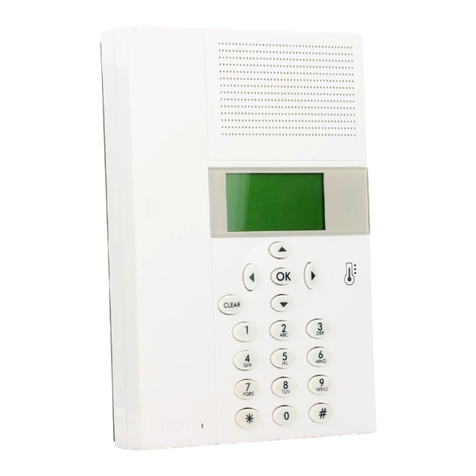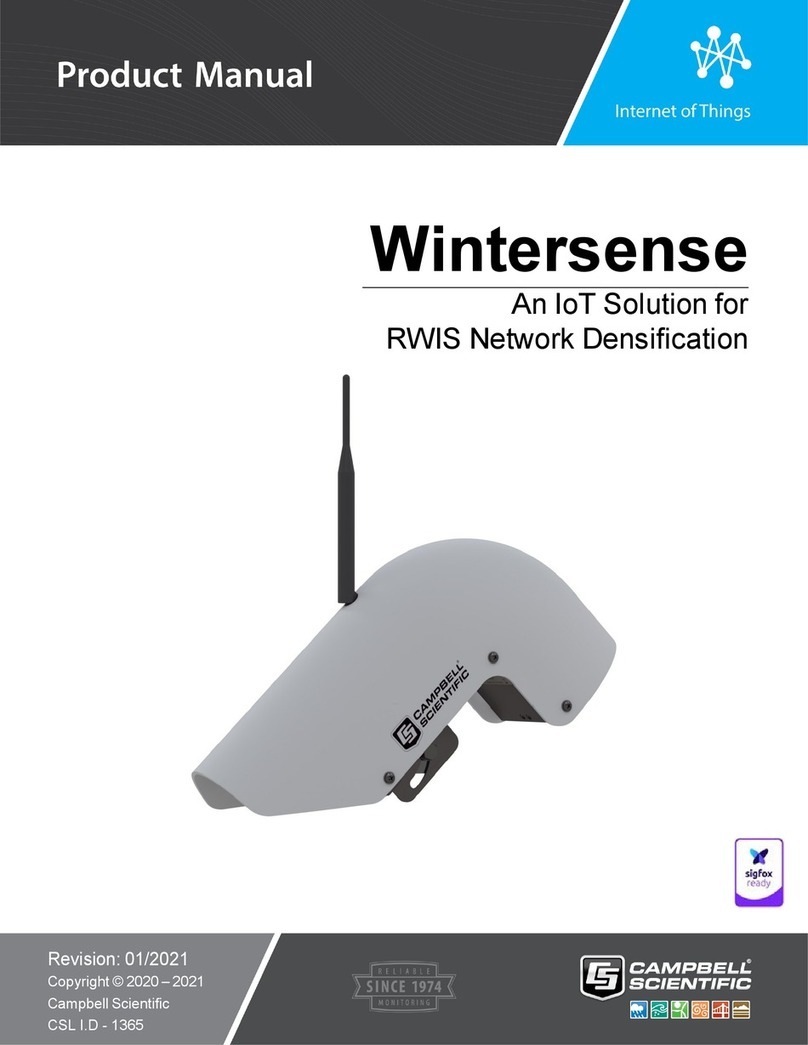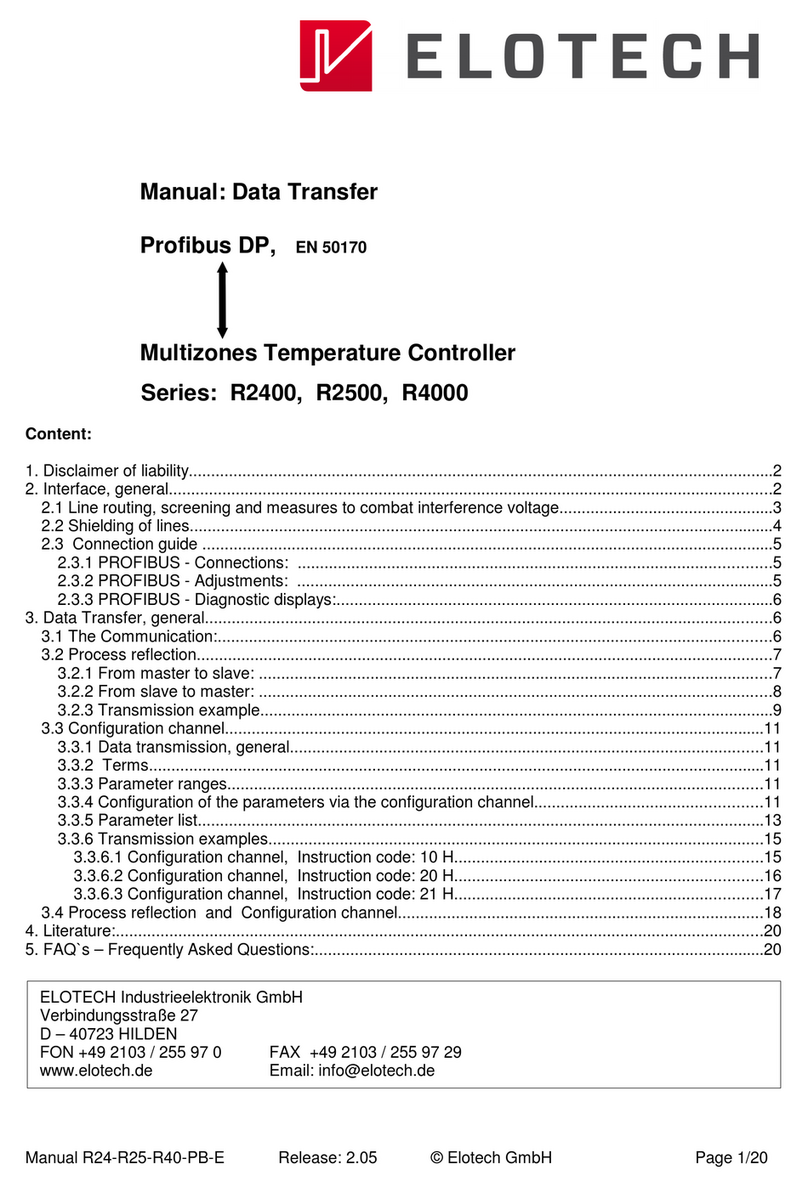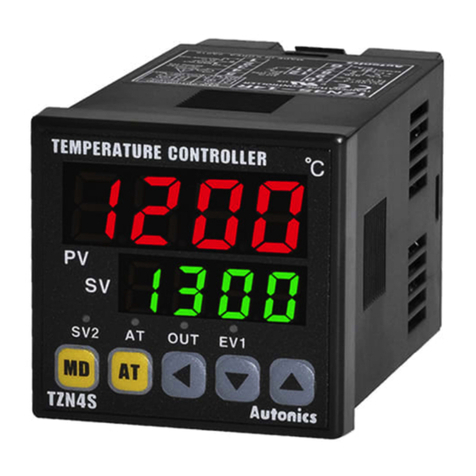Decagon GS3 User manual

Operator’s Manual
Decagon Devices, Inc.
Version: December 1, 2014 — 11:53:59

GS3
Decagon Devices, Inc.
2365 NE Hopkins Court
Pullman WA 99163
Phone: 509-332-5600
Fax: 509-332-5158
Website: www.decagon.com
Trademarks
c
2011-2014 Decagon Devices, Inc.
All Rights Reserved
ii

GS3 CONTENTS
Contents
1 Introduction 1
1.1 Customer Support . . . . . . . . . . . . . . . . . . . . 1
1.2 Specifications ....................... 2
1.3 Warranty ......................... 3
2 Theory 5
2.1 Volumetric Water Content . . . . . . . . . . . . . . . . 5
2.2 Temperature ....................... 5
2.3 Electrical Conductivity . . . . . . . . . . . . . . . . . . 5
2.4 Converting Bulk EC to Pore EC . . . . . . . . . . . . 6
2.5 Pore Water vs. Solution EC . . . . . . . . . . . . . . . 7
2.6 Reference ......................... 8
3 Calibration 9
4 Connecting Sensors 10
4.1 Connecting to an Em50/Em50R logger . . . . . . . . . 10
4.2 3.5mm Stereo Plug Wiring . . . . . . . . . . . . . . . . 10
4.3 Connecting to a Non-Decagon Logger . . . . . . . . . 11
5 Communication 13
5.1 Serial Communication . . . . . . . . . . . . . . . . . . 13
5.2 SDI-12 Communication . . . . . . . . . . . . . . . . . 13
5.3 SensorBus ........................ 15
5.4 Address .......................... 15
5.5 Power ........................... 16
5.6 Reading .......................... 16
5.7 Campbell Scientific Programs . . . . . . . . . . . . . . 17
6 Installing the Sensors 18
6.1 Orientation ........................ 18
6.2 Removing the Sensors . . . . . . . . . . . . . . . . . . 19
6.3 Cleaning the Probes . . . . . . . . . . . . . . . . . . . 19
7 Troubleshooting 21
8 Declaration of Conformity 23
iii

GS3 1 INTRODUCTION
1 Introduction
Thank you for choosing Decagons GS3 Greenhouse Sensor. We de-
signed the GS3 to measure the water content, electrical conductivity
and temperature of many types of growing media. Decagon devel-
oped the GS3 primarily to work in greenhouse applications where
the slim, stainless steel needles could be inserted easily into many
types of substrates, but it can work in many other applications as
well. This manual guides you through the sensor features and how
to use it successfully.
1.1 Customer Support
If you ever need assistance with your GS3, or if you just have ques-
tions or feedback, there are several ways to contact us. Customer ser-
vice representatives are available to speak with you Monday through
Friday, between 7am and 5pm Pacific time.
Note: If you purchased your GS3 through a distributor, please con-
tact them for assistance.
Email:
Phone:
509-332-5600
Fax:
509-332-5158
If contacting us by email or fax, please include as part of your mes-
sage your instrument serial number, your name, address, phone, and
fax number.
1

1 INTRODUCTION GS3
1.2 Specifications
Volumetric Water Content
Accuracy: εa:±1εa(unitless) from 1 to 40 (soil range), ±15% from
40 to 80:
•Using a generic calibration: ±0.03 m3
m3(±3% VWC) typical
in mineral soils that have solution electrical conductivity <5
dS/m
•Using medium specific calibration, ±0.01 to 0.02 m3
m3(±1 to
2% VWC) in any porous medium
Resolution:
•εa: 0.1 εa(unitless) from 1 to 20
•<0.75 εa(unitless) from 20 to 80
•0.002 m3
m3(0.2% VWC) from 0 to 40% VWC
•0.001 m3
m3(0.1% VWC) >40% VWC
Range: Apparent dielectric permittivity (εa): 1 (air) to 80 (water)
Bulk Electrical Conductivity
Accuracy: ±5% from 0 to 5 dS/m, ±10% from 5 to 23 dS/m, user
calibration required above 10 dS/m
Resolution: 0.001 dS/m from 0 to 23 dS/m
Range: 0 to 25 dS/m (bulk)
Temperature
Accuracy: ±1◦C
Resolution: 0.1 ◦C
Range: -40 to 60 ◦C
General Specifications
Dimensions: 9.3 x 2.4 x 6.5 cm
Prong Length: 5.5 cm
Dielectric Measurement Frequency: 70 MHz
Measurement Time: 150 ms (milliseconds)
Power requirements: 3.6 to 15 VDC, 0.03 mA quiescent, 25 mA dur-
ing 150 ms measurement
2

GS3 1 INTRODUCTION
Output: Serial TTL, 3.6 Volt Levels or SDI-12
Operating Temperature: -40 to 60 ◦C1
Connector types: 3.5 mm (stereo) plug or stripped & tinned lead
wires (Pigtail)
Cable Length: 5 m standard; custom cable length available upon
request
1.3 Warranty
The GS3 has a one year warranty on parts and labor. The warranty
activates when the instrument arrives at your location.
Seller’s Liability
Seller warrants new equipment of its own manufacture against defec-
tive workmanship and materials for a period of one year from date of
receipt of equipment (the results of ordinary wear and tear, neglect,
misuse, accident and excessive deterioration due to corrosion from
any cause are not to be considered a defect); but Seller’s liability for
defective parts shall in no event exceed the furnishing of replacement
parts F.O.B. the factory where originally manufactured. Material
and equipment covered hereby which is not manufactured by Seller
shall be covered only by the warranty of its manufacturer.
Seller shall not be liable to Buyer for loss, damage or injuries to
persons (including death), or to property or things of whatsoever
kind (including, but not without limitation, loss of anticipated prof-
its), occasioned by or arising out of the installation, operation, use,
misuse, nonuse, repair, or replacement of said material and equip-
ment, or out of the use of any method or process for which the same
may be employed. The use of this equipment constitutes Buyer’s
acceptance of the terms set forth in this warranty. There are no
understandings, representations, or warranties of any kind, express,
implied, statutory or otherwise (including, but without limitation,
1Sensors can be used at higher temperatures. Please contact Decagon for
assistance.
3

1 INTRODUCTION GS3
the implied warranties of merchantability and fitness for a particular
purpose), not expressly set forth herein.
4

GS3 2 THEORY
2 Theory
2.1 Volumetric Water Content
The GS3 sensor uses an electromagnetic field to measure the dielec-
tric permittivity of the surrounding medium. The sensor supplies a
70 MHz oscillating wave to the sensor prongs that charges according
to the dielectric of the material. The stored charge is proportional to
substrate dielectric and substrate volumetric water content. The GS3
microprocessor measures the charge and outputs a value of dielectric
permittivity from the sensor. The dielectric value is then converted
to substrate water content by a calibration equation specific to the
media you are working in.
2.2 Temperature
The GS3 uses a small thermistor to take temperature readings. It is
located underneath the sensor overmold, next to one of the prongs
so it remains in thermal equilibrium with the medium, and reads the
temperature of the prong surface.
The GS3 outputs temperature in ◦C unless otherwise stated in your
preferences file in either the DataTrac 3 or ECH2O Utility programs.
It is important to note that even though the sensor head is white,
if it is in direct sunshine, the temperature measurement may read
high. Exposure of the sensor head to direct UV radiation may also
degrade the vinyl surface and cause it to discolor.
Use caution when installing the sensor with the overmold in the sun.
2.3 Electrical Conductivity
Electrical conductivity (EC) is the ability of a substance to conduct
electricity and can be used to infer the amount of polar molecules that
are in solution. EC is measured by applying an alternating electri-
cal current to two electrodes, and measuring the resistance between
5

2 THEORY GS3
them. Conductivity (referred to as “bulk electrical conductivity”)
is derived by multiplying the inverse of the resistance (conductance)
by the cell constant (the ratio of the distance between the electrodes
to their area). GS3 bulk EC measurements are normalized to EC at
25 ◦C We factory calibrate the bulk EC measurement to be accurate
within ±10% from 0 to 10 dS/m. This range is adequate for most
greenhouse and nursery applications.
However, some special applications in highly saline substrates may
require measurements with bulk EC greater than the specified range.
The GS3 will measure up to 23 dS/m bulk EC, but user calibration
is required above 10 dS/m. Additionally, EC measurements above
10 dS/m are very sensitive to contamination of the electrodes by skin
oils, etc. Be sure to read the sensor cleaning section at the end of
the manual if you plan to measure the EC of salty soils.
2.4 Converting Bulk EC to Pore EC
For many applications, it is advantageous to know the electrical con-
ductivity of the solution contained in the soil pores (σp), which is
a good indicator of the solute concentration in the soil. Tradition-
ally, σphas been obtained by extracting pore water from the soil and
measuring σpdirectly. As one would expect, this is a time consuming
and labor intensive process.
The GS3 measures the electrical conductivity of the bulk soil sur-
rounding the sensors (σb). A considerable amount of research has
been conducted to determine the relationship between σband σp.
Work by Hilhorst (2000), has taken advantage of the linear relation-
ship between the soil bulk dielectric permittivity (εb) and σbto allow
accurate conversion from σbto σpif the εbis known. The GS3 mea-
sures εband σbnearly simultaneously in the same soil volume. It is
therefore well suited to this method.
The pore water conductivity can be determined from (see Hilhorst,
2000 for derivation):
σp=pσp
b−σb=0
(1)
6

GS3 2 THEORY
where σpis the pore water electrical conductivity (dS/m); εPis
the real portion of the dielectric permittivity of the soil pore wa-
ter (unitless); σbis the bulk electrical conductivity, (dS/m), which is
measured directly by the GS3; εbis the real portion of the dielectric
permittivity of the bulk soil (unitless); εσb=0 is the real portion of the
dielectric permittivity of the soil when bulk electrical conductivity is
0 (unitless). εcan be calculated from soil temperature using:
εp= 80.3−0.37 ∗(Tsoil −20) (2)
where Tsoil is the soil temperature (◦C) measured by the GS3.
Finally, εσb=0 is an offset term loosely representing the dielectric per-
mittivity of the dry soil. Hilhorst (2000) recommended that εσb=0 =
4.1 be used as a generic offset. However, our research in several agri-
cultural soils, organic, and inorganic growth media indicates that
εσb=0 = 6 results in more accurate determinations of σp. Hilhorst
(2000) offers a simple and easy method for determining for individ-
ual soil types, which will improve the accuracy of the calculation of
σpin most cases.
Our testing indicates that the above method for calculating σpresults
in good accuracy (±20%) in moist soils and other growth media. In
dry soils where VWC is less than about 0.10 m3/m3, the denomi-
nator of equation 1 becomes very small, leading to large potential
errors. We recommend that p not be calculated in soils with VWC
<0.10 m3
m3using this method.
2.5 Pore Water vs. Solution EC
As noted in the previous section, pore water electrical conductivity
can be calculated from bulk EC using the sensor-measured dielec-
tric permittivity of the medium. However, pore water EC is not the
same as solution EC. Pore water EC is the electrical conductivity
of the water in the pore space of the soil. One could measure this
directly if the soil was squeezed under high pressure to force water
out of the soil matrix and that water was collected and tested for
EC. Solution EC is the electrical conductivity of pore water removed
from a saturated paste. In this case, the soil is wetted with distilled
7

2 THEORY GS3
water until the soil saturates, then the soil is placed on filter paper in
a vacuum funnel and suction is applied. An electrical conductivity
measurement on the water removed from the sample will give the
solution electrical conductivity.
Theoretically, the two are related by the bulk density. An exam-
ple calculation will illustrate this relationship: A soil is at 0.1 m3
m3
VWC, has a pore water EC of 0.7 dS/m, and a bulk density of 1.5
Mg/m3.
We can calculate the solution EC as follows.
φ= 1 −ρb
ρs
= 1 −1.5
2.65 = 0.43 (3)
Solution EC = σpΘ + σd(φ−Θ)
φ=0.7(0.1) + 0
0.43 = 0.162 dS/m (4)
In this example, φis the porosity, ρbis bulk density, ρsdensity of
the minerals (assumed to be 2.65 Mg/m3), subscript dis distilled
water, and Θ is volumetric water content. We assume that the EC
of the distilled water is 0 dS/m. In practice, solution EC calculated
from this method and solution EC taken from a laboratory soil test
may not agree well because wetting soil to a saturated paste is very
imprecise.
2.6 Reference
Hilhorst, M.A. 2000. A pore water conductivity sensor. Soil Science
Society of America Journal 64:6 1922-1925
8

GS3 3 CALIBRATION
3 Calibration
Dielectric Permittivity
In some specific cases, a calibration that gives dielectric permittivity
(combined real and imaginary) for the GS3 is useful. The dielectric
of the medium, εais the standard factory calibrated output of the
GS3 before applying a calibration.
Calibration for Soilless Media
The GS3 has been calibrated in media types including potting soil,
perlite and peat. The goal of these calibrations is to create a generic
calibration equation that will work in all types of each substrate, with
an accuracy of better than ±5% volumetric water content (VWC). If
you need more accuracy, you can perform a media-specific calibration
to get the accuracy down to ±1 to 2%. It is interesting to note that
the main difference between the calibrations is caused by the high
air volume in the organic soils that lowers the starting (dry media)
dielectric of the sensor. For more information on how to calibrate
your probes, please see http://www.decagon.com/support. Decagon
also has a calibration service, where we will perform the calibration
for a standard fee. Contact Decagon for more information about this
calibration service.
The calibration for several potting soils, perlite, and peat moss at
salinities ranging from 0 to >4 dS/m is given:)
V W C(m3
m3)=0.118√a−0.117 (5)
The calibration for mineral soils ranging from 0 to >5 dS/m is:
V W C(m3
m3)=5.89 x 10−6ε3−7.62 x 10−4ε2+3.67 x 10−2ε−7.53 x 10−2
(6)
9

4 CONNECTING SENSORS GS3
4 Connecting Sensors
The GS3 sensor was designed to work most efficiently with Decagon’s
Em50, Em50R, Em50G or our ProCheck handheld reader. They can
also be used with other data loggers, such as those from Campbell
Scientific, Inc. The GS3 requires an excitation voltage in the range
of 3.6 to 15 V and outputs at 3.6 V levels. Although capable of
communicating in TTL serial, the GS3 can also be interrogated us-
ing the SDI-12 protocol with the sensor continuously powered (see
section 6).
4.1 Connecting to an Em50/Em50R logger
The GS3 has been designed to work specifically with the Em50 data
logger. To download data to your computer, you will need to install
ECH2O Utility, DataTrac 3 or a terminalport program on your com-
puter. The following software support the GS3 sensor.
Em50 Firmware version 2.05
ECH2O Utility 1.62 or greater
DataTrac 3.3 or greater
Please check your software version to ensure it will support the GS3.
To update your software to the latest versions, please visit Decagon’s
support site at http://www.decagon.com/support/.
To use the GS3 with your Em50 data logger, simply plug the stereo
plug into one of the five ports on the data logger and use either
ECH2O Utility, or DataTrac 3 software (see respective manuals) to
configure that port for the GS3 and set the measurement interval.
4.2 3.5mm Stereo Plug Wiring
GS3 sensors used with Decagon loggers come with a 3.5 mm “stereo
plug”connector. The stereo plug allows for rapid connection directly
to Decagon’s Em50 and Em50R data loggers and to the hand-held
10

GS3 4 CONNECTING SENSORS
ProCheck readers. Below is a diagram showing the wiring configu-
ration for this connector.
Figure 1: Stereo Plug
4.3 Connecting to a Non-Decagon Logger
GS3 sensors may be purchased for use with non-Decagon data log-
gers. These sensors typically come pre-configured with stripped and
tinned (pigtail) lead wires for use with screw terminal.
Refer to your distinct logger manual for details on wiring.
Our integrator’s guide gives detailed instructions on connecting the
GS3 sensor to non-Decagon loggers. Please visit www.decagon.com/support
for the complete integrator’s guide.
Figure 2: Pigtail Wiring
GS3 sensors with the stripped and tinned cable option can be made
with custom cable lengths (up to 1000 ft) on a per-foot fee basis.
This option gets around the need for splicing wire (a possible failure
point). Connect the wires to the data logger as shown, with the
supply wire (white) connected to the excitation, the digital out wire
(red) to a digital input, the bare ground wire to ground as seen below.
11

4 CONNECTING SENSORS GS3
Figure 3: Wiring Diagram
NOTE: The acceptable range of excitation voltages is from 3.6 to 15
VDC. If you wish to read the GS3 with the Campbell Scientific Data.
Loggers, you need to power the sensors off of the 12 V port (switched
if you use TTL serial).
If your GS3 is equipped with the standard 3.5 mm plug, and you
wish to connect it to a non-Decagon data logger, you have two op-
tions. First, you can clip off the plug on the sensor cable, strip and
tin the wires, and wire it directly into the data logger.
This has the advantage of creating a direct connection with no chance
of the sensor becoming un-plugged; however, it then cannot be eas-
ily used in the future with a Decagon readout unit or data logger.
The other option is to obtain an adapter cable from Decagon. The
3-wire sensor adapter cable has a connector for the sensor jack on
one end, and three wires on the other end for connection to a data
logger (this type of wire is often referred to as a “pigtail adapter”).
Both the stripped and tinned adapter cable wires have the same ter-
mination as seen above; the white wire is excitation, red is output,
and the bare wire is ground.
Note: Be extra careful to secure your stereo to pigtail adapter con-
nections to ensure that sensors do not become disconnected during
use.
12

GS3 5 COMMUNICATION
5 Communication
The GS3 sensor can communicate using two different methods, Se-
rial (TTL) and SDI-12. In this chapter we will briefly discuss the
specifics of each of these communication methods.
Please visit www.decagon.com/support for the complete Integrators
guide, which gives more detailed explanations and instructions.
5.1 Serial Communication
The GS3 communicates in both serial and SDI-12. In some applica-
tions where non-Decagon data loggers are used, SDI-12 will be the
best choice.
When excitation voltage is applied, the GS3 makes a measurement.
Within about 50 ms of excitation three measurement values are
transmitted to the data logger as a serial stream of ASCII char-
acters. The serial out is 1200 baud asynchronous with 8 data bits,
no parity, and one stop bit. The voltage levels are 0 to 3.6 V and the
logic levels are TTL (active low). The power must be removed and
reapplied for a new set of values to be transmitted.
The ASCII stream contains three numbers separated by spaces. The
stream is terminated with the carriage return character. The first
number is the dielectric permittivity (ε), the second number is tem-
perature in ◦C, and the third is the electrical conductivity in µS/cm.
5.2 SDI-12 Communication
The GS3 sensor can also communicate using the SDI-12 protocol,
a three-wire interface where all sensors are powered (white wire),
grounded (bare wire), and communicate (red wire) on shared wires
(for more info, go to www.sdi-12.org). There are some positive and
negative elements of this protocol. On the positive side, up to 62 sen-
sors can be connected to the same 12 V supply and communication
13

5 COMMUNICATION GS3
port on the data logger. This simplifies wiring because no multi-
plexer is necessary. On the negative side, one sensor problem can
bring down the entire array (through a short circuit, etc.). To avoid
this problem, we recommend the user make an independent junction
box with wire harnesses where all sensor wires are connected to wire
lugs so sensors can be disconnected if a problem arises. A single three
wire bundle can be run from the junction box to the data logger.
The SDI-12 protocol requires that all sensors have a unique address.
GS3 sensors come from the factory with an SDI-12 address of 0. To
add more than one SDI-12 sensor to a system, the sensor address
must change. Address options include 0...9, A...Z, a...z. There are
two ways to set the SDI-12 sensor address. The best and easiest is
to use Decagon’s ProCheck (if the option is not available on your
ProCheck, please upgrade to the latest version of firmware).
SDI-12 addressing can be accessed in the “Config” menu by selecting
“SDI-12 Address” and pressing “Enter.” To change the SDI-12 ad-
dress, press the up and down arrows until you see the desired address
and push “Enter.” SDI-12 communication allows many parameters
to be communicated at once, so you can also see things like the sen-
sor model, SDI-12 version, etc. SDI-12 communication is also sup-
ported in Campbell Scientific data loggers like the CR10X, CR1000,
CR3000, etc. Direct SDI-12 communication is supported in the “Ter-
minal Emulator” mode under the “Tools” menu on the “Connect”
screen. Detailed information on setting the address using CSI data
loggers can be found on our website at http://www.decagon.com/sup
port/downloads/.
The sensor can be powered using any voltage from 3.6 to 15 VDC,
but 12 V is optimal. The SDI-12 protocol allows the sensors to be
continuously powered, and we recommended that the power (white
wire) be connected to a continuous 12 VDC source. However, the
sensor can also be used with a switched 12 V source. This can help
reduce power use (although the GS3 sensors use very little power,
0.03 mA quiescent)) and will allow the sensor array to be reset if a
problem arises.
14

GS3 5 COMMUNICATION
Reading the GS3 sensor in SDI-12 mode using a CSI data logger re-
quires a function call. An example program from Edlog and CRBasic
can be found in the software section of http://www.decagon.com/sup
port/. The dielectric permittivity (ε) is the first number output by
the sensor, the second number is temperature in ◦C, and the third is
the electrical conductivity in µS/cm.
5.3 Sensor Bus
The SDI-12 protocol allows up to 62 sensors to be wired together
at once. This requires that all sensor supply (white) wires are con-
nected together, all digital out (red) wires are connected together,
and all ground (bare) wires are connected together. Sharing these
wires is often called a “bus,” which means that communication runs
along the common digital out wire and each sensor, as well as the
host, will “hear” all communication.
Communication is therefore addressed specifically to each sensor.
For example, when a reading is needed, the host will first address the
specific sensor that needs to make a measurement, tell it to make a
measurement, then tell it to send its answer back to the host. Please
note that, because the supply wire is in common with all sensors, a
problem with a single sensor can be catastrophic to the bus system.
A short circuit on one sensor (from shovel-blight, for example) will
bring the entire bus down until that sensor is removed from the bus.
5.4 Address
SDI-12 sensors communicate on a three-wire bus. To avoid complete
chaos, each sensor is given a unique address so the host can com-
municate to each sensor directly. This address can be any number
from 0 to 9, any letter from capital A to Z, and any letter from small
a to z. Every sensor MUST have a unique address on the system,
otherwise two or more sensors will respond at once to a host request,
creating confusion and data loss. Sensors are shipped from the fac-
tory with an address of “0.” Thus, if you plan on using SDI-12 with
15

5 COMMUNICATION GS3
multiple sensors on a single bus, you will have to start by addressing
your sensors individually as noted in the section above.
5.5 Power
The GS3 is an extremely low power sensor; when continuously pow-
ered, but not making a measurement or communicating, it uses 30µA.
When using the sensor as part of an SDI-12 bus, it is recommended
that the sensors be excited continuously to avoid issues with initial
sensor startup interfering with the SDI-12 communications.
5.6 Reading
One of the advantages of the SDI-12 protocol is the number of possi-
ble queries that can be made to the sensor. From the standard sensor
readings (dielectric, temperature, and EC) to calibration coefficients,
several parameters can be stored in the sensor and read back. For
typical use, all that is needed is a simple output of dielectric, temper-
ature, and EC. The sequence to gather those values is quite simple
(Address the sensor |tell it what you want it to do |end with a “!”).
For example:
0R0! (Address sensor “0” |take an instantaneous reading “R0” |end
the statement “!”)
Most data loggers will run this sequence without any user input,
but occasionally it is necessary to interrogate the sensor directly. A
full list of the SDI-12 commands implemented in the GS3 is available
by contacting Decagon.
Additional examples of SDI-12 programs can be found at our software
section online at http://www.decagon.com/support/downloads.
16

GS3 5 COMMUNICATION
5.7 Campbell Scientific Programs
The GS3 is a SDI-12 compatible sensor. This makes programming
for the sensor in CRBasic or Edlog straightforward. Simply choose
the SDI-12 Recorder command and input the necessary parameters.
As mentioned earlier, the sensor outputs three values, so be sure to
define your array size as 3 in CRBasic (i.e. Public GS3Out(3)) or
leave room for two more parameters after your “Loc” call in Edlog.
Example programs can be found at www.decagon.com/support.
17
Table of contents
Popular Temperature Controllers manuals by other brands
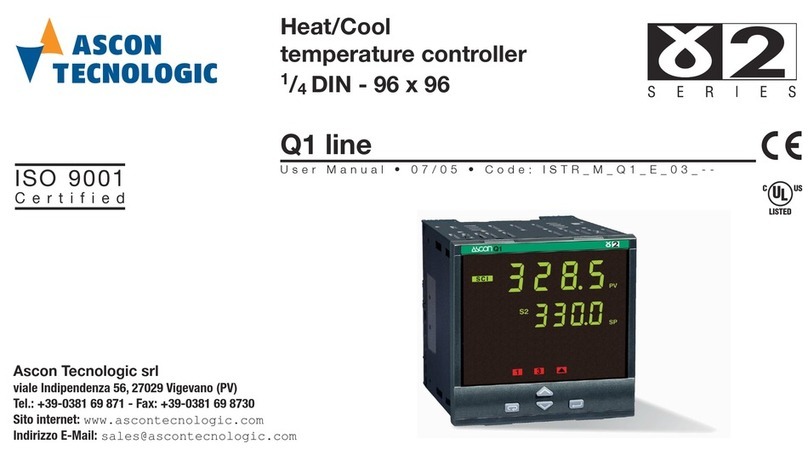
Ascon tecnologic
Ascon tecnologic 2 Series user manual
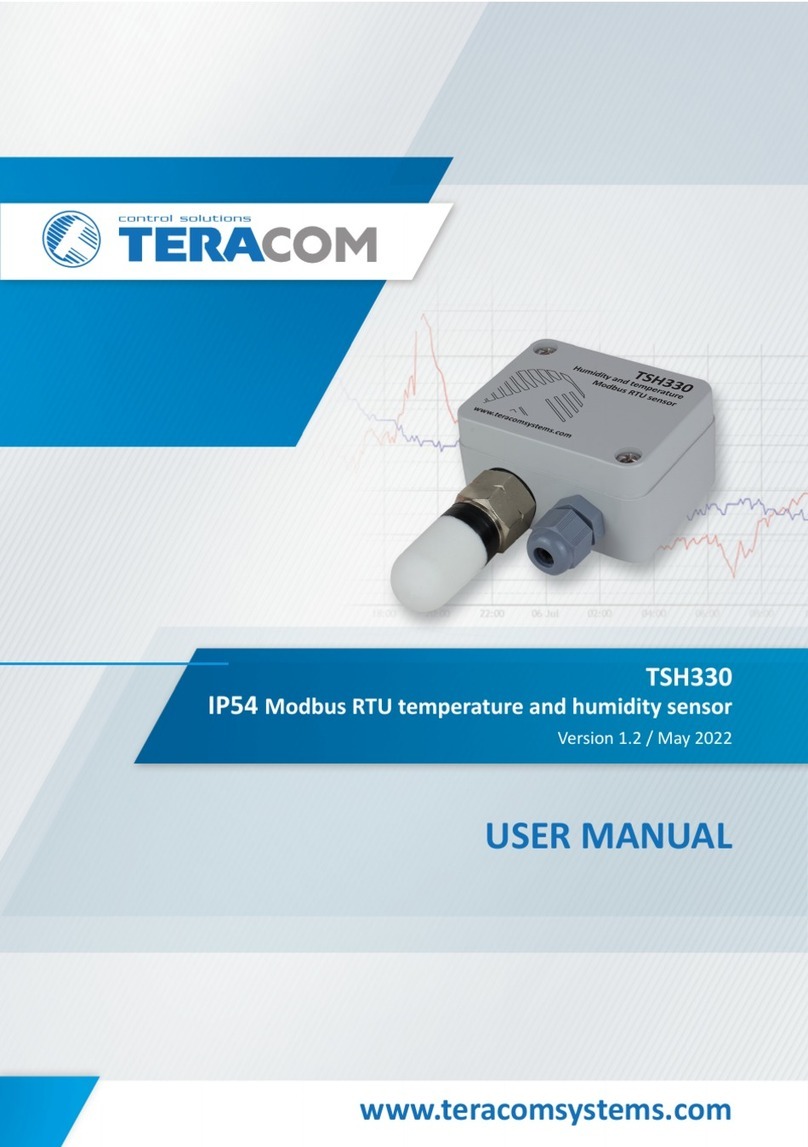
Teracom
Teracom TSH330 user manual

Barnant Company
Barnant Company 689-0010 operating instructions
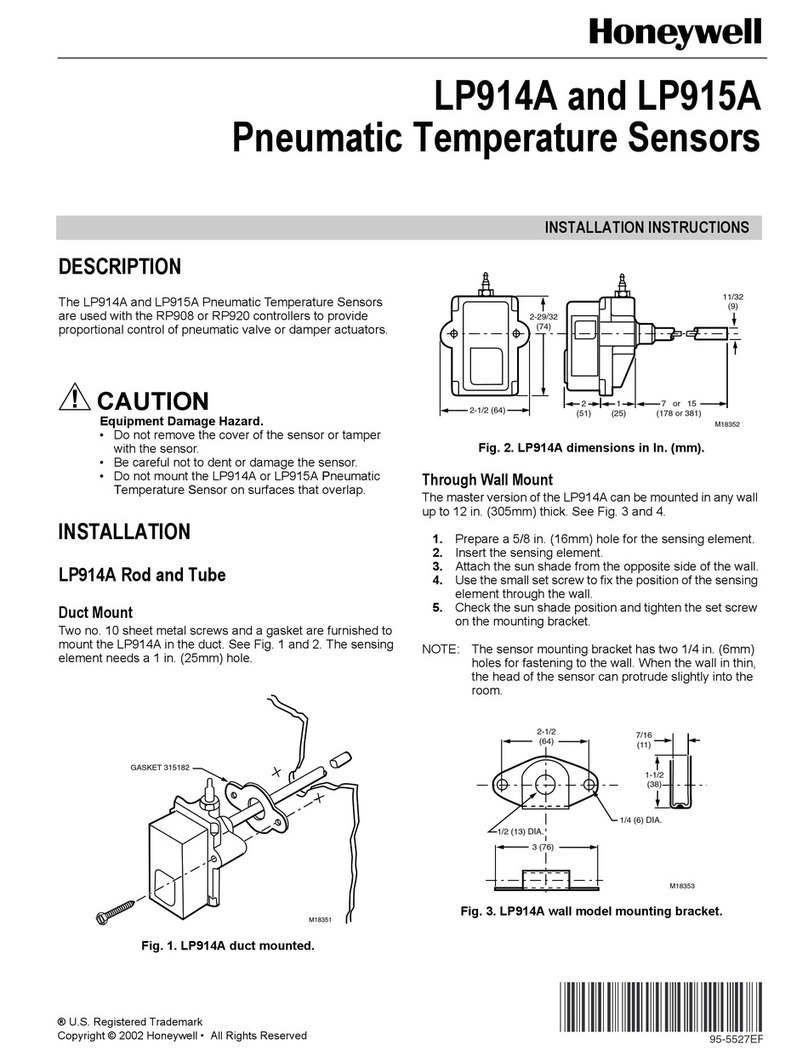
Honeywell
Honeywell LP914A installation instructions
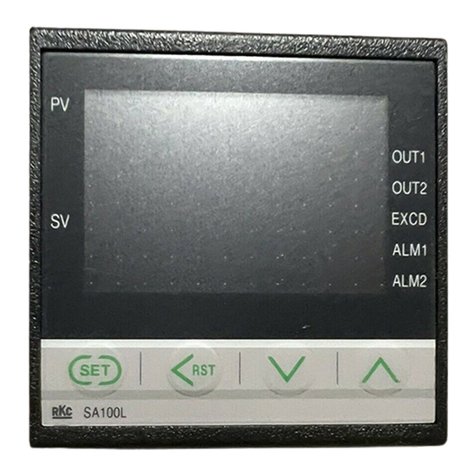
RKC INSTRUMENT
RKC INSTRUMENT SA100L Communication instruction manual

Arrow Springs
Arrow Springs ASC/5 quick start

ECOWITT
ECOWITT WN1821 instruction manual
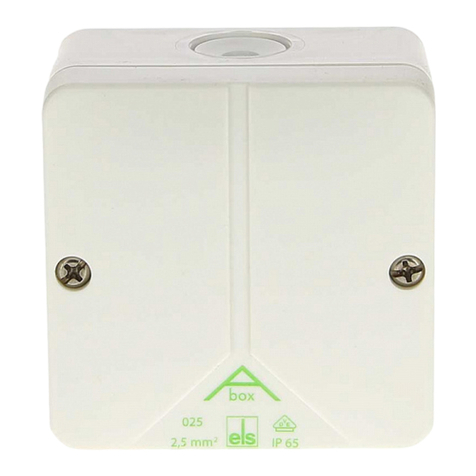
Watts
Watts BT-OS02-RF quick start guide

Durex industries
Durex industries RB100 installation manual
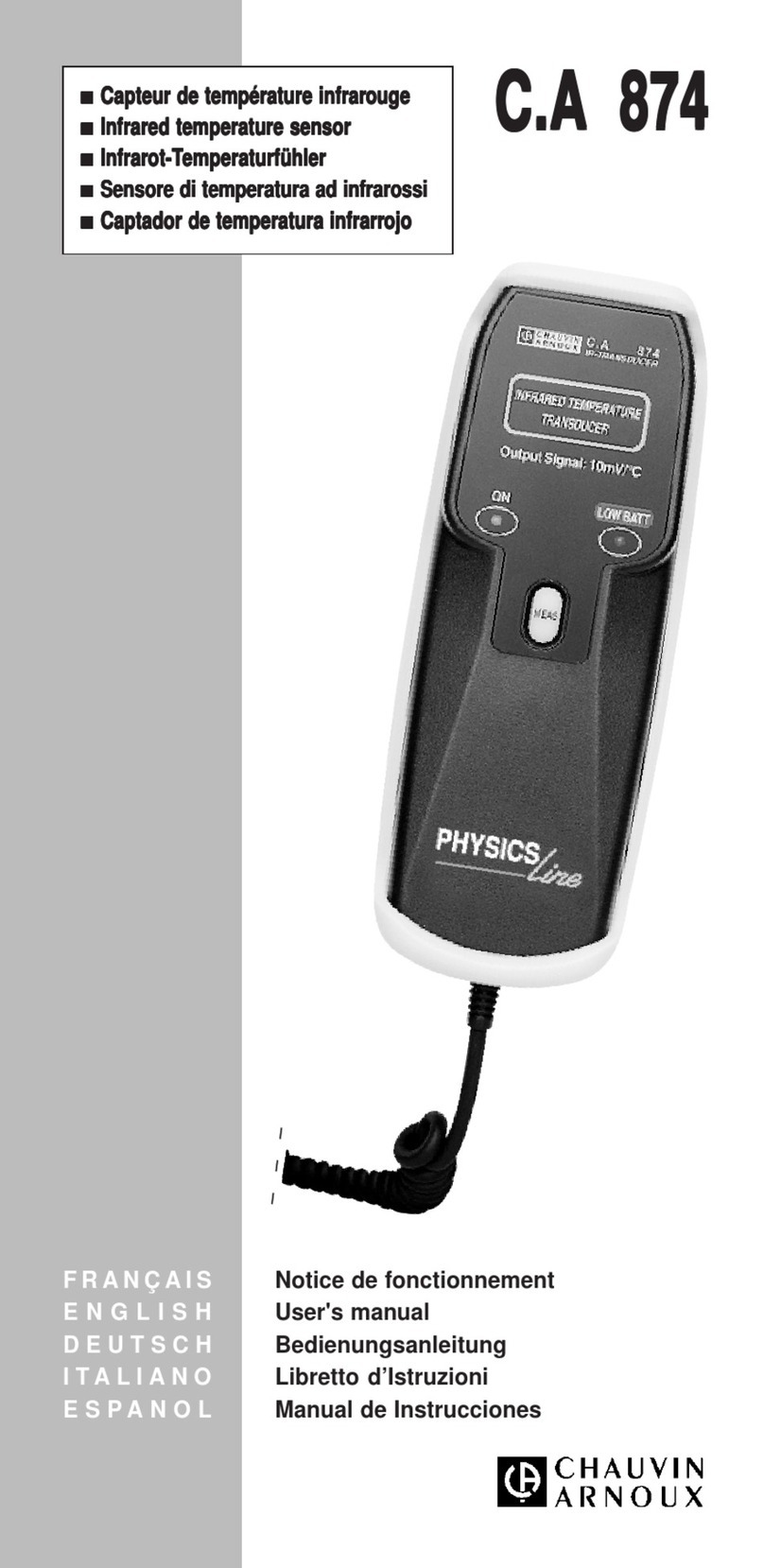
Chauvin Arnoux
Chauvin Arnoux PHYSICS Line C.A. 874 user manual
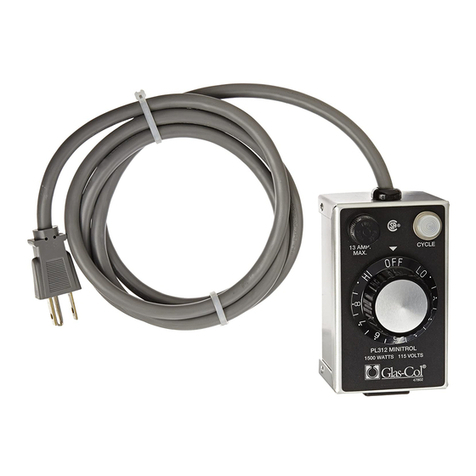
Glas-Col
Glas-Col Minitrol Series User instructions

Watlow Electric
Watlow Electric 935A Series user manual
